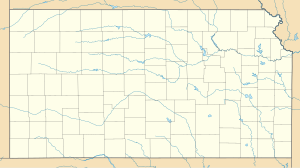Olathe Air Force Station
This article needs additional citations for verification. (December 2012) |
| Olathe Air Force Station Air Defense Command (ADC) | |
|---|---|
| Coordinates | 38°50′06″N 094°54′16″W / 38.83500°N 94.90444°W |
| Type | Air Force Station |
| Code | ADC ID: P-72, NORAD ID: Z-72 |
| Site information | |
| Controlled by | |
| Site history | |
| Built | 1951 |
| In use | 1951–1968 |
| Garrison information | |
| Garrison | 738th Aircraft Control and Warning (later Radar) Squadron |
Olathe Air Force Station is a former United States Air Force radar station that was located in Gardner, Kansas. It was located next to Naval Air Station Olathe, now the grounds of New Century AirCenter.
History
In 1950 the
Receiving the Defense Secretary's approval on 21 July, the Air Force directed the Army Corps of Engineers to proceed with construction of a radar station on the western part of the ground station, about a mile from the runway and ramp/hangars being used by the Navy. Additional housing units were also constructed at Olathe to accommodate the Air Force personnel. The Federalized
The Ground Air Transmitting Receiving (GATR) Site for communications was located at 38°50′27″N 094°54′19″W / 38.84083°N 94.90528°W, approximately 0.4 miles north from the main site. Normally the GATR site was connected by a pair of buried telephone cables, with a backup connection of dual telephone cables overhead. The Coordinate Data Transmitting Set (CDTS) (AN/FST-2) at the main site converted each radar return into a digital word which was transmitted by the GATR via microwave to the Control Center.
The national guardsmen were replaced by the
Olathe AFS used these radars in conjunction with the
In 1958, the
In addition to the main facility, Olathe AFS operated the
- Garland, KS (P-72A) 37°45′40″N 094°38′51″W / 37.76111°N 94.64750°W
In late 1959 this station was also performing air-traffic-control duties for the
The radar squadron provided information 24/7 the SAGE Direction Center where it was analyzed to determine range, direction altitude speed and whether or not aircraft were friendly or hostile. On 31 July 1963, the site was redesignated as NORAD ID Z-72. Over the years, the equipment at the station was upgraded or modified to improve the efficiency and accuracy of the information gathered by the radars.
In September 1968 the Air Force inactivated the 738th Radar Squadron due to budget reductions and a general phase-down of Air Defense Command. The Army inactivated the Nike-Hercules AADCP in 1969[2][3][4]
See also
References
![]() This article incorporates public domain material from the Air Force Historical Research Agency
This article incorporates public domain material from the Air Force Historical Research Agency
- ^ Wikimapia: Nike Site KC-65DC
- ^
 This article incorporates public domain material from the Air Force Historical Research Agency
This article incorporates public domain material from the Air Force Historical Research Agency
- ^ A Handbook of Aerospace Defense Organization 1946–1980, by Lloyd H. Cornett and Mildred W. Johnson, Office of History, Aerospace Defense Center, Peterson Air Force Base, Colorado
- ^ Winkler, David F. (1997), Searching the skies: the legacy of the United States Cold War defense radar program. Prepared for United States Air Force Headquarters Air Combat Command.


